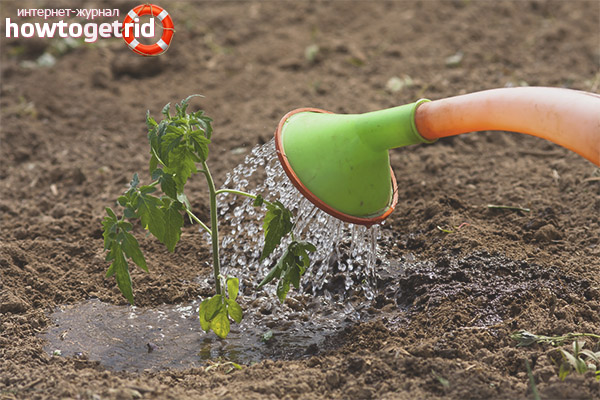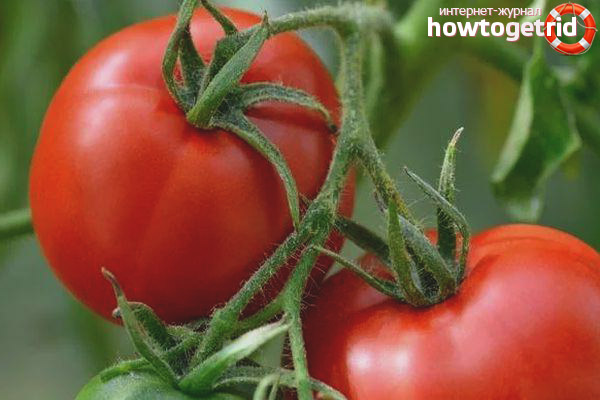The content of the article
The regiment commander is a semi-determinant variety of pink tomatoes. Plants are resistant to viral and fungal diseases. These tomatoes have a high yield and resistance to cracking. The fruits are very sweet, fleshy, with a small amount of seeds.
Description
Tomato Regiment Commander is a half-tall variety with very large raspberry fruits. The bush reaches 1-1.2 m in height, has dark green large leaves. The plant requires shaping and tying to the support. This variety is suitable for processing for juice, tomato paste, ketchup.
Cultivation and care
At the current high cost of seeds, tomatoes should be grown through potted seedlings. Seedlings are planted at the age of 30-50 days in open ground or greenhouses after May 20, when the threat of frost passes. Two rows are placed after 60 cm, plants in rows are planted after 50 cm. The length of the beds is arbitrary. With a high trellis, the stems are tied with twine (as in a greenhouse), throwing the tops of the lashes through the rail.
Before sowing, the seeds are soaked in a weak solution of potassium permanganate. After the potassium permanganate solution, the seeds are washed with water to swell.
Protection against diseases and fertilizers
The use of chemical protection methods should be minimal. Planting seedlings should be as far apart as possible, so that the bushes do not interfere with each other and do not fight for a place in the sun.
- It is most correct to plant a seedling at a distance of 70-80 cm from the neighbors. The crown of the leading bushes will not allow the sun's rays to fall on their relatives.
- Do not skimp on the place, give the seedlings as much space as possible, if you neglect this advice, then the upper part of the plant will darken all the plants near you.
- Chemical methods currently remain basic, but their use can be successfully combined with biological and mechanical methods.
- Processing tomatoes with folk remedies will save a significant part of the crop. In addition to traditional means of controlling late blight, you can use proven folk remedies. In June, the bushes are sprayed with a Bordeaux mixture. They are used to combat diseases infusion of marigolds and wormwood.
For digging in the fall, it is advisable to bring humus, it must be combined with the upper fertile soil layer. In the spring, superphosphate must be added to the beds.
In the absence of this component, you can use a kilogram of wood ash. Spread fertilizers evenly over the entire area of the ridge, close up with digging or loosening.
It is recommended to spray with 4 - 5% urea solution, this will protect the plants from viral and fungal diseases.
- To combat late blight, they use infusion of fresh hay along with sodium disubstituted phosphate and sulfur preparations. In rainy years, the treatment is repeated after 10-11 days.
- The first signs of the disease are manifested in yellowing and drying of the leaves. Affected fruits and shoots stop growing, the fruits become small, inedible.
- Excessive moisture, especially on moist soils, contributes to the intense spread of disease.
Watering and shelter

Garden owners often wonder which watering to choose. Mechanical watering is not for all gardeners, since it requires a lot of physical effort, it takes a lot of time to water the entire garden or garden. For this reason, gardeners give preference to drip irrigation systems.
- Drop watering allows you to increase the yield of tomatoes and at the same time reduce the amount of water used.Watering is carried out regularly, water is supplied slowly at a certain time.
- The system consists of a pipeline through which water flows through the droppers to the plants. When using drip irrigation, the risk of leaf and fruit diseases is minimized. Water is supplied in limited quantities, and this significantly reduces weed growth. It is possible to use the supply of plants with useful substances at the same time as watering.
- Tomatoes are heat-loving plants, when the temperature drops to + 5-10 degrees, the plant growth stops, the ovaries fall, the yield decreases. You can protect tomato plantings with a covering material - geotextiles.
- Geotextile is a material made from stabilized propylene fibers. Being a completely neutral compound, geotextiles are not able to enter into reactions and, accordingly, do not emit harmful substances.
- Staying under this cloak, plants feel very comfortable, as they are protected from adverse environmental conditions and receive all the necessary components for their existence - water, light, air.
- Significantly accelerating the ripening time, the gardener receives super-early products, realizing which he gains higher profits.
It is impossible not to mention return frosts in the second half of spring, which can destroy the entire crop. Using agrofibre as protection, gardeners and gardeners will protect themselves from this trouble.
Video: a unique way of watering and fertilizing tomatoes










Submit